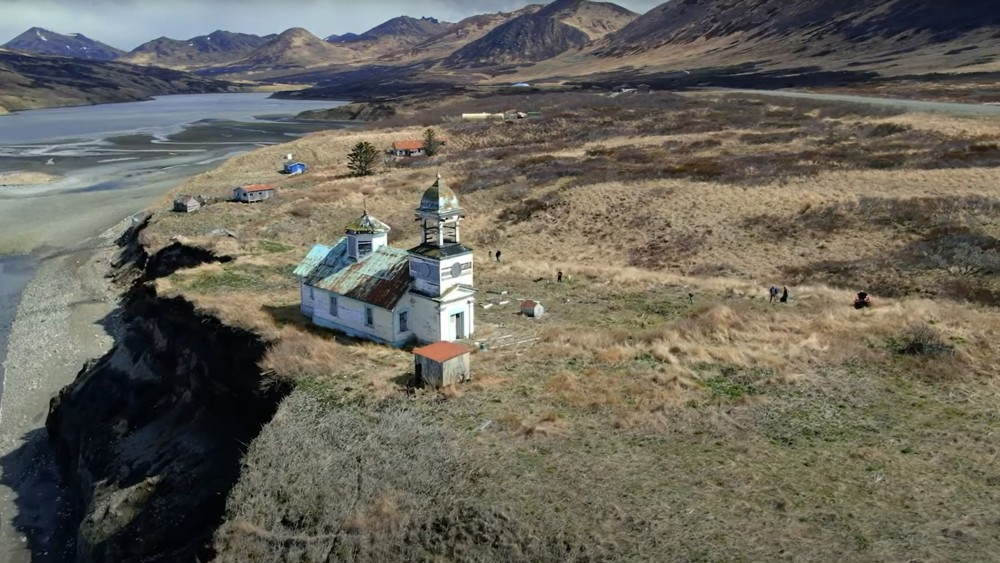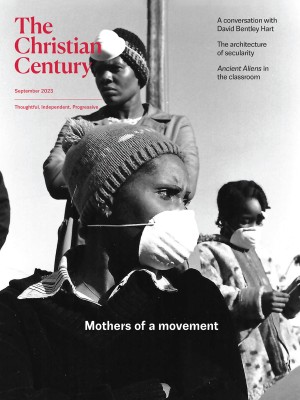Preservation of church and planet
“The least green thing,” says Bob Jaeger of Partners for Sacred Places, “is to tear down and replace the building.”

An aerial view of Ascension of Our Lord Orthodox Church in Karluk, Alaska, on Kodiak Island. (Courtesy photo)
Here’s one way churches can combat climate change: by preserving their buildings, rather than replacing them or selling them to someone who will.
“The most ecologically friendly building is one you already have,” said CJ Armstrong, senior architect and vice president at Multistudio in Lawrence, Kansas. “If you don’t have to build new or if you can figure out how to reuse it, that’s honestly the most sustainable thing that you can do.”
Armstrong specializes in adaptive reuse, with a focus on religious spaces. He explained the environmental cost of demolishing a building.
“There’s a ton of embodied energy in every building we put up,” he said. “That’s all the energy that goes into the construction material. So that’s everything from digging it out of the ground or cutting the tree down, transporting it to be processed, the actual processing of it, then the transporting across the country to the job site, then the labor to put it together.”
Read our latest issue or browse back issues.
When buildings are demolished, he said, what can be salvaged easily is removed first—but often that amounts to only the copper wiring and any other precious metals. Most building materials are one-time use, so they go to the landfill. The cycle of demolishing and rebuilding contributes to excess emissions, which exacerbate climate change—and that’s just one of the steep costs of losing a historic building that is often a de facto community center.
Yet many congregations find themselves facing an uncertain future—one that may involve divesting their church home. Demographic changes over decades have led to congregations with smaller, older memberships. A 2020 report from Faith Communities Today found that 33 percent of church participants are 65 or older, while that age group makes up only 17 percent of the general population. In 42 percent of mainline Protestant churches, at least half the members are 65 or older.
This can leave a handful of people taking care of a large, older building in need of often expensive upkeep and repairs. Along with feeling empty, church buildings can be overwhelming for the remaining members, said Bob Jaeger, president and cofounder of Partners for Sacred Places. The Philadelphia-based organization aims to keep congregations in their building or help them pass it along to another organization with a similar community focus. The result is often saving not just a building but a hub of community.
Jaeger’s passion for religious architecture stems from a fascination with stained glass. As a young man living in Ann Arbor, Michigan, he began photographing and researching the beautiful, intricate windows he found in many churches. That interest led to a career in historic preservation, which is a focus of his organization.
Partners provides financial grants and consulting to help churches create plans for sustaining their buildings and their position as a community center. They provide creative solutions for keeping historic buildings in use. “The least green thing, in my opinion, is to tear down and replace the building,” Jaeger said.
To avoid this undesirable option, the organization walks churches through several steps to find options other than simply posting a For Sale sign out front.
“A lot of folks assume that churches are fully using their buildings, or they have to sell,” Jaeger said. “What I would say is most churches are in the in-between categories.”
Partners consultants often start with a simple open house or meetings with key leaders in the community. Jaeger said bringing in people from outside the congregation often provides fresh perspectives, both on the space and on the community services the church may already be providing. The civic value of a sacred place is often immense, he said, but may go unrecognized by the community and even the church’s members.
Partners has identified 120 common ways that churches often serve the community at large, ranging from soup kitchens and food pantries to preschools to housing houseless populations. The organization commissioned a study which found that 87 percent of the beneficiaries of community programs taking place in church buildings are not members of the congregation. The study measured the economic impact of the average historic sacred space in an urban environment at $1.7 million annually.
“We think it’s so important nationally and locally to make a case that these are not just places of worship, but they are civic spaces,” Jaeger said. “A lot of civic leaders that we talked to have no idea. . . . Congregations, by the way, don’t really know this either. Even though they run these buildings, they haven’t really thought about this. And it’s important because [while] we’re trying to help redefine these places in a way, we’re not denying their essential purposes as places of worship.”
Once congregations have a broader picture of the services they provide to the greater community, the next step is to tell the story and include the community in fundraising campaigns, Jaeger said, broadening the financial base beyond congregational tithing.
Seeking outside perspectives can also lead to creative solutions for unused space. Partners has worked with many churches to figure out space-sharing options. Some have found success in sharing their building with other congregations, Jaeger said. Others may lease space to a nonprofit that holds similar values. These solutions help to diversify revenue streams, bringing in more funds for building upkeep.
In cases where a sale is necessary, Jaeger advocates for a “civic-minded sale,” in which the congregation may stipulate possible uses for the building going forward, such as housing a nonprofit. When selling, being hands-off is the worst option, he said, because the church has no control over the fate of its building.
“It seems to contradict the whole purpose of a congregation, which is, yes, to worship and serve but also to be in the community and to help the community. And to walk away from that community at the end seems to undermine all the work that the congregation has done,” he said.
One key factor for a successful building transition is not waiting until the last moment, Jaeger said.
“Another problem is a lot of [congregations] are not really facing this fully until it’s too late, and then they feel they have no choice,” he said. “So what we say is, hey, anticipate this, think about this in advance, plan it, and you may have more options than you realize.”
For some historic churches, a special injection of funding can help remediate problems that, if left unchecked, could lead to potential demolition in the future. Russian Orthodox Sacred Sites in Alaska, works to preserve historic Russian Orthodox churches, many of them built when Alaska was Russian territory. Its website concisely sums up the struggle: “Our Alaskan communities face tough choices as it is often more costly to restore a historic building than to build a newer, simpler, often less elegant, house of worship.”
Russian Orthodox congregations have felt the effects of climate change acutely, said Dorothy Gray, chair of ROSSIA’s board of directors. She said many churches were built along the Alaskan coastline, which has suffered steady erosion from rising sea levels, increased wave action, and stronger storms—all of which endanger church structures and their adjoining cemeteries.
One example is the Ascension of Our Lord Chapel in Karluck, a village on Kodiak Island. After more than a century as a beacon for fishermen along the shore, the Karluck River has chipped away at the bluff, leaving one corner of the church less than 10 feet from the edge of a cliff.
ROSSIA took emergency action to move the structure 80 feet inland, and it is working on moving the church again, to a final destination upriver. Its cemetery also will have to be moved and remains reinterred, as graves may become exposed in the current location, Gray said.
Moving a historic building is no easy task, but in Alaska, the process faced extra challenges and great expense. For the initial move of 80 feet, a crew was flown in, and equipment had to be shipped from Anchorage to Seward, Gray said. The equipment was then taken to Kodiah Island by barge, which involved going around the coast of the island to get to Karluck and wait for a nine-foot tide to be able to dock and unload. The temporary move alone cost half a million dollars, Gray said.
But preservation is paramount, said Gray—because in addition to their role in their communities, the churches represent an important slice of Alaskan history. Of the 30 Russian Orthodox churches in the state, six are National Historic Landmarks and 23 are listed on the National Register of Historic Places. Many are prominent tourist attractions in their town or village.
Tackling such projects requires funding from multiple sources. Gray said ROSSIA works with historic preservation organizations at the local, state, and federal levels; state senators; private donors; and Native corporations to source funding for its projects. It also has received grants from Partners for some of its projects. The National Park Service has provided invaluable in-kind services from a historical architect and archaeologists, Gray said.
Finding funding or new uses to maintain existing church buildings is a crucial commitment congregations can make to fight climate change. But preservation ultimately benefits individuals and the community in a concrete way.
Armstrong, the architect, reflected on the church where he and his wife were married in Hutchinson, Kansas.
“It’s a great space, and I hope it’s around when my kids get married. When they have kids, we can take them through and show them that’s where grandma and grandpa got married,” he said. “That kind of stuff is important, and I would hate to see it get to a point where the building is considered a disposable item and it’s best just to start new.
“There’s just so much familial history and cultural memory tied in with these buildings, more so than some other types, that I think is important to keep around. . . . It’s about keeping the community’s history and memory alive.”
This article is part of “Growing a Green Church,” an ongoing series focused on churches’ efforts to steward their buildings and land effectively in the context of a changing climate. The project is produced in collaboration with the Christian Century, Episcopal News Service, Faithfully Magazine, National Catholic Reporter, and Sojourners, with support from the Solutions Journalism Network and funding from the Fetzer Institute.





